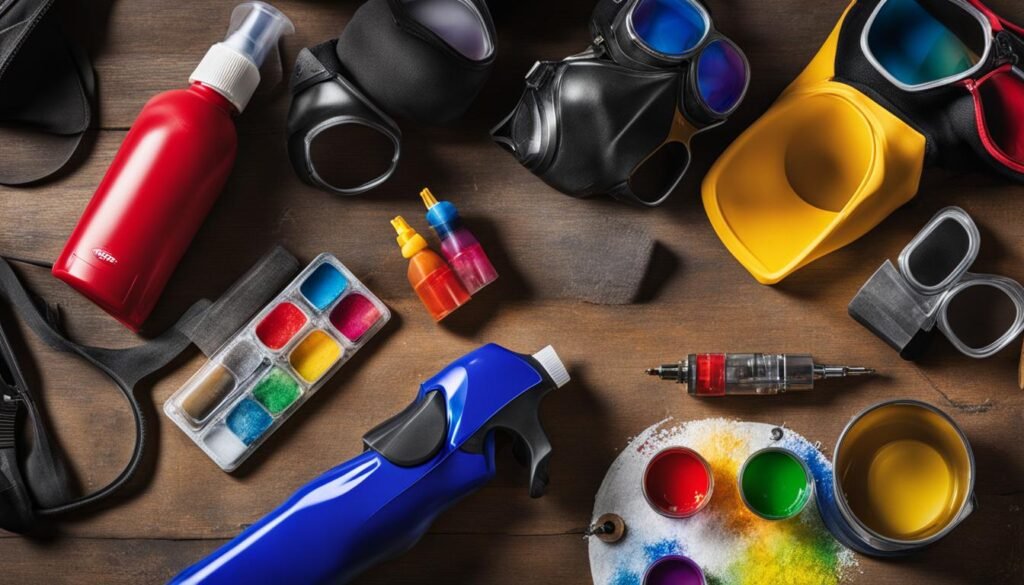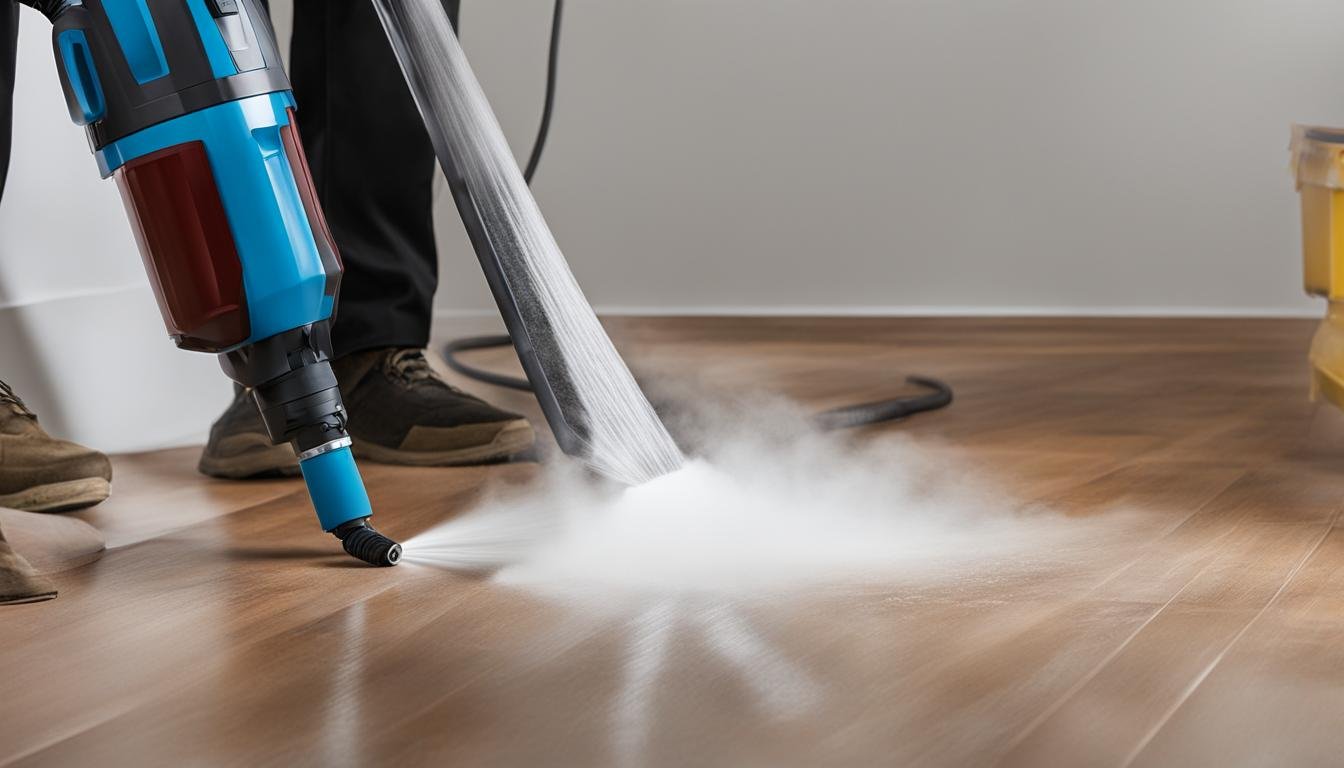Spray painting can be a challenging task, especially when it comes to painting difficult surfaces or achieving professional-quality results. However, knowing how to use a vacuum cleaner to spray paint can make the process surprisingly easy. With the right technique and equipment, you can transform your ordinary DIY projects at home into something extraordinary. In this article, I will guide you step-by-step on how to effectively use a vacuum cleaner to spray paint and provide you with useful tips and best practices for successful spray painting.
Key Takeaways:
- Using a vacuum cleaner as a spray paint tool can simplify the spray painting process.
- With the right technique and equipment, you can achieve professional-quality results.
- Follow the step-by-step guide to effectively use a vacuum cleaner for spray painting.
- Utilize useful tips and best practices for successful spray painting.
- Transform your DIY projects at home into something extraordinary with a vacuum cleaner and spray paint.
How to use a vacuum cleaner to spray paint? Basic rules.
Before we dive into the specifics of using a vacuum cleaner for spray painting, it’s important to understand some basic rules and best practices for spray painting in general. These rules will help you achieve better results and avoid common mistakes.
- Clean the Surface: Start by ensuring that the surface is clean and free of dirt and dust. Use a suitable solvent to wipe the surface and remove any contaminants.
- Consider Chemical Compatibility: It’s also important to consider chemical compatibility between the primer and top coat. Using products from the same manufacturer and with similar formulations will yield the best results.
- Follow Time Intervals: Following the recommended time intervals between coats is crucial for proper adhesion and a smooth finish.
- Prime the Surface: Priming the surface before painting is usually recommended, as it helps with adhesion, leveling, and surface preparation.
- Sweep the Paint: Make sure to sweep the paint over the surface instead of holding the spray nozzle in one position to avoid runs in the paint.
By following these basic rules and best practices, you can improve the quality of your spray painting projects and achieve professional-looking results.
Quote:
“Clean surfaces, proper priming, and sweeping motions are key techniques for successful spray painting.” – Emily Smith, Spray Paint Expert
Here are a few additional tips for successful spray painting:
- Work in a well-ventilated area to ensure proper air circulation.
- Cover surrounding surfaces to protect them from overspray.
- Use light coats to prevent drips and achieve even coverage.
- Keep the spray can or gun at a consistent distance from the surface for uniform application.
- Wear appropriate protective gear, such as goggles and gloves, to protect yourself from fumes and paint splatters.
Now that you’re familiar with the basic rules and tips for successful spray painting, let’s move on to the specifics of using a vacuum cleaner as a spray paint tool.
Choosing the Right Spray Paint and Accessories
To spray paint effectively with a vacuum cleaner, it’s important to choose the right spray paint and accessories. There are various specialized spray paints available for different applications, such as automotive quality finishes, fabric coatings, and rust protection. It’s crucial to select a spray paint that is suitable for your specific project and surface.
When it comes to spray paint options, consider brands like Rust-Oleum, Krylon, and Seymour Paint. These brands offer a wide range of choices and have received positive reviews for their spray paint quality and performance. By choosing a trusted brand, you can be confident in the outcome of your spray paint job.
In addition to the right spray paint, using spray paint accessories can greatly enhance the adhesion and durability of your paint job. Spray cleaners, degreasers, and primers are valuable tools that can prepare the surface for painting, ensuring optimal results.
Remember, choosing the right spray paint and accessories is essential for achieving a professional finish. Take the time to research and select the best options for your project, and you’ll be rewarded with outstanding results.
Popular Spray Paint Brands
| Brand | Specialties | Customer Reviews |
|---|---|---|
| Rust-Oleum | Offers various finishes, including automotive, metallic, and textured | Positive reviews for durability and color selection |
| Krylon | Known for its wide range of color options and quick-drying formula | Positive reviews for ease of use and coverage |
| Seymour Paint | Specializes in industrial-grade spray paints, including high-heat and corrosion-resistant options | Positive reviews for durability and professional-quality finish |
Note: The table above showcases popular spray paint brands, their specialties, and customer reviews. It can help you make an informed decision when choosing the right spray paint brand for your project.

Conclusion
After exploring the technique of using a vacuum cleaner for spray painting, we can conclude that it is a valuable tool for DIY enthusiasts and professionals alike. By adhering to the basic rules of spray painting and selecting the right spray paint and accessories, you can achieve impressive results with ease.
Starting with a clean surface is essential for a smooth finish. Ensure that the primer and top coat are chemically compatible to maximize adhesion and durability. Following the recommended time intervals between coats allows for proper drying and optimal results. To achieve a flawless finish, it is crucial to test drive the spray paint before applying it, adjusting the distance and speed as needed.
Always prioritize safety by wearing appropriate protective gear and working in a well-ventilated area. By following these tips and techniques, you can elevate your DIY projects and transform ordinary objects into extraordinary pieces of art.
So, what are you waiting for? Grab your vacuum cleaner and get ready to unleash your creativity through spray painting. Happy painting!
FAQ
How can I use a vacuum cleaner to spray paint?
To use a vacuum cleaner for spray painting, you’ll need to attach the spray paint can to the vacuum cleaner’s hose. Hold the vacuum cleaner nozzle close to the surface you want to paint and activate the spray paint can. Move the vacuum cleaner nozzle and spray paint can together in smooth, even strokes to apply the paint. The vacuum cleaner will help contain the paint overspray and suck up any excess paint particles.
What are the basic rules for successful spray painting?
To achieve successful spray painting results, make sure the surface is clean and free of dirt and dust. Use a suitable solvent to wipe the surface before painting. Consider the chemical compatibility between the primer and top coat. Follow the recommended time intervals between coats. Prime the surface before painting for better adhesion and preparation. Avoid holding the spray nozzle in one position to prevent paint runs. Sweep the paint over the surface instead.
How do I choose the right spray paint and accessories?
When choosing spray paint, consider the specific project and surface you’re working with. There are specialized spray paints for automotive finishes, fabric coatings, and rust protection. Popular spray paint brands include Rust-Oleum, Krylon, and Seymour Paint. Accessories like spray cleaners, degreasers, and primers can enhance adhesion and durability. Read reviews and look for feedback to ensure you choose high-quality spray paint and accessories.
What are some best practices for spray painting with a vacuum cleaner?
To spray paint effectively with a vacuum cleaner, start with a clean surface and maintain chemical compatibility between the primer and top coat. Follow the recommended time intervals between coats. Test the spray paint on a test surface to determine the optimal distance and speed for a smooth finish. Wear appropriate protective gear and work in a well-ventilated area. By following these best practices, you can achieve professional-looking results with ease.
What are the benefits of using a vacuum cleaner for spray painting?
Using a vacuum cleaner as a spray paint tool helps contain the paint overspray, reducing the mess and cleanup required. It also helps in sucking up any excess paint particles, resulting in a cleaner working environment. Additionally, using a vacuum cleaner can provide more control and precision during the spray painting process, leading to better results.





Leave a Reply